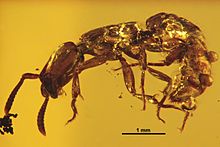Acanthostichus hispaniolicus
|
Acanthostichus hispaniolicus Temporal range: Burdigalian? |
|
|---|---|
 |
|
| Acanthostichus hispaniolicus holotype | |
| Scientific classification | |
| Kingdom: | Animalia |
| Phylum: | Arthropoda |
| Class: | Insecta |
| Order: | Hymenoptera |
| Family: | Formicidae |
| Genus: | Acanthostichus |
| Species: | A. hispaniolicus |
| Binomial name | |
|
Acanthostichus hispaniolicus De Andrade, 1998 |
|
Acanthostichus hispaniolicus is an extinct species of ant in the subfamily Dorylinae known from a group of possibly Miocene fossils found on Hispaniola. A. hispaniolicus is the first species of the ant genus Acanthostichus to have been described from fossils found in Dominican amber and is the only species of Acanthostichus found in the West Indies.
Acanthostichus hispaniolicus is known from four fossils insects which are inclusions in a single, transparent chunk of Dominican amber. The amber was produced by the extinct Hymenaea protera, which formerly grew on Hispaniola, across northern South America and up to southern Mexico. The amber specimens, numbers Do-5205-1, Do-5205-2, Do-5205-3, and Do-5205-4; which entomb the holotype and three paratypes, are currently preserved in the Division of Invertebrate Zoology collections at the Staatliches Museum für Naturkunde Stuttgart in Stuttgart, Germany. The holotype and paratype fossils are composed of complete adult workers which were originally preserved in the same amber specimen along with a number of other insects. The specimen, now cut into smaller pieces, was collected from an undetermined amber mine, in fossil bearing rocks of the Cordillera Septentrional mountains, northern Dominican Republic. The amber dates from at least the Burdigalian stage of the Miocene, based on studying the associated fossil foraminifera and may be as old as the Middle Eocene, based on the associated fossil coccoliths. This age range is due to the host rock being secondary deposits for the amber, and the Miocene the age range is only the youngest that it might be.
...
Wikipedia
